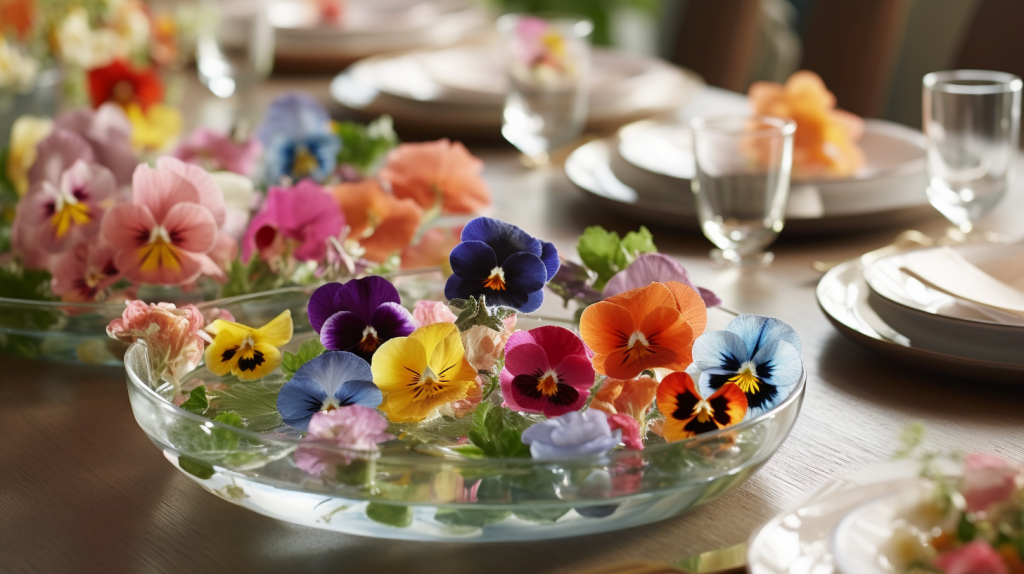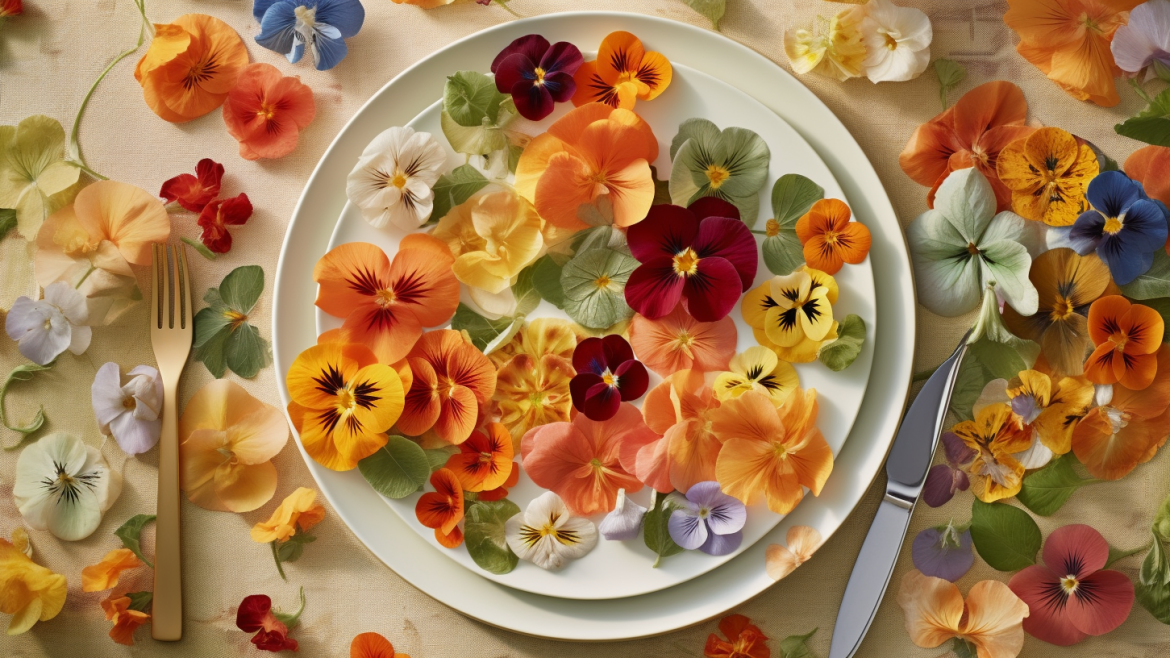Stepping into your garden, you are not merely treading on a patch of earth. You are embarking on a time-traveling adventure through centuries of culinary history. Edible flowers, those delicate feasts for both the palate and the eyes, have adorned the plates of our ancestors from the Roman times. The Victorians, in their elegant sophistication, crystallized violets for their desserts, while the Native Americans, resourceful and in tune with nature, found myriad uses for sunflowers. From the chrysanthemums in Asia to the marigolds in Mexico, cultures across the globe have discovered and cherished the unique floral flavors that we are only now beginning to re-explore in earnest.1 2
This culinary history, although ancient, is far from being a thing of the past. Today, as we increasingly value organic, locally sourced ingredients and innovative culinary experiences, the practice of incorporating flowers into our diets is experiencing a renaissance. As we rediscover this age-old tradition, we are opening up a world of vibrant flavors, stunning colors, and profound nutritional benefits that go far beyond mere sustenance.
Moreover, edible flower gardening is not just about producing flavorful, colorful ingredients. It’s also about creating a deeper connection with nature, with our food, and with the cycles of life that govern them. When we cultivate, harvest, and consume our own edible flowers, we are participating in a cycle that is as old as humanity itself. It’s a profoundly grounding experience, a reminder of our place in the larger web of life.
A Symphony of Flavors: The Rainbow Palette of Edible Flowers

If your palate has grown weary of the same old flavors, then the world of edible flowers is ready to take you on a vibrant journey of culinary exploration. Consider the spicy kick of nasturtiums, capable of breathing life into a simple salad, or the citrusy notes of begonias, which can surprise and delight in cocktails. Pansies, with their grassy sweetness, find a perfect partner in fruit salads, while the tart, cranberry-like flavor of hibiscus offers a delightful surprise in teas and desserts.
Exploring this world of floral cuisine opens up a veritable treasure trove of culinary possibilities. Imagine the culinary adventures that await you as you discover the peppery bite of rocket flowers, the mild cucumber flavor of borage, or the anise-like taste of fennel blossoms. Each flower is a new experience, a new flavor, a new texture to explore and experiment with.
In addition, the variety of flavors that edible flowers offer is matched only by the range of colors they bring to the table. From the vibrant reds and yellows of marigolds to the soft purples and blues of borage and pansies, edible flowers can make your dishes as visually stunning as they are delicious. The palette of edible flowers is as diverse and exciting as any artist’s, offering you a myriad of ways to create dishes that are truly works of art.
Nourishing Nature’s Way: The Nutritional Powerhouse of Edible Blooms
One of the most rewarding aspects of edible flower gardening is discovering the nutritional benefits these delightful blooms bring. Beyond their flavor and beauty, edible flowers are a nutritional powerhouse. They’re rich in vitamins A and C, helping to boost your immune system and promote overall health. They’re also a good source of essential minerals like calcium and iron, which are vital for maintaining strong bones and healthy blood.3
Moreover, many edible flowers are known for their medicinal properties. Take calendula, for example, known for its anti-inflammatory benefits and its ability to support skin health. Or echinacea, which has been used for centuries to boost the immune system and ward off common illnesses. So, when we eat these flowers, we’re not just enjoying their unique flavors and beautiful colors. We’re also nourishing our bodies in profound ways, benefiting from the wisdom of nature and the generations who have gone before us.4
Eating flowers then becomes more than an epicurean delight; it’s a holistic journey towards better health. It’s about embracing a way of eating that is as nourishing as it is enjoyable, as health-giving as it is aesthetically pleasing. It’s about understanding that the food we eat can be both a source of pleasure and a source of wellness, and that these two aspects are, in fact, deeply intertwined.
Art on a Plate: The Visual Charm of Edible Flowers
Edible flowers have a unique ability to transform ordinary dishes into extraordinary ones. Their vibrant colors and delicate shapes can turn even the simplest dish into a work of art. Imagine a bowl of fresh salad dotted with the yellows and reds of marigolds, or a cake decorated with the pastel hues of pansies—it’s like painting with nature’s own palette.
The addition of edible flowers to your dishes not only enhances their aesthetic appeal but also creates a sensory dining experience that leaves a lasting impression. It’s about adding an extra layer of delight to the act of eating, a visual feast that enhances the flavors on the plate. It’s about creating dishes that are as beautiful to look at as they are delicious to eat, dishes that can surprise and delight in equal measure.
Moreover, presenting dishes adorned with edible flowers can make any meal feel like a special occasion. Whether you’re hosting a dinner party or simply cooking for yourself, incorporating edible flowers into your dishes can turn any meal into a culinary celebration. It’s a way to bring the beauty and bounty of the garden into your kitchen, and from there, onto your plate.
Safety First: The Critical Art of Identifying Edible Flowers
While the world of edible flowers is exciting, it’s crucial to tread carefully. Not all flowers are edible, and some can even be dangerous if consumed. Accurate identification is key—many flowers may look alike, but not all are safe to eat. Some can be toxic, and others may cause allergic reactions. It’s therefore essential to do your research and ensure that the flowers you’re considering eating are indeed safe.
In addition, always ensure that your flowers are free from pesticides and other chemicals. This means either growing your own in an organic garden, or sourcing them from a trusted supplier who can guarantee that they’ve been grown without harmful substances.
And remember, when introducing a new flower into your diet, it’s best to start small to see how your body reacts. Like any new food, edible flowers can cause allergic reactions in some people, so it’s best to approach them with caution, especially at the beginning.
From Garden to Plate: The Practical Uses of Edible Flowers
Edible flowers offer a unique opportunity to bring your garden directly to your kitchen table. They can be used in a myriad of ways: tossed into salads for a splash of color, infused into oils and vinegars for a subtle flavor, folded into pastries for a surprising twist, or even frozen into ice cubes for a stunning addition to your beverages. The possibilities are as boundless as your imagination.
Creating dishes with edible flowers is a culinary adventure, a chance to experiment with flavors, textures, and colors in a whole new way. Whether you’re a seasoned chef or a cooking novice, edible flowers can bring a fresh, exciting dimension to your cooking. They invite you to see your meals not just as sustenance, but as a form of creative expression, a way to bring beauty, pleasure, and health-giving nutrition into your everyday life.
Moreover, using edible flowers in your cooking can help to deepen your connection with the natural world. When you prepare and consume the very flowers you’ve grown, you’re not just eating; you’re participating in a cycle of life that connects you to the rhythms of nature. It’s a tangible reminder of where our food comes from, and of the care, patience, and skill that goes into growing it.
Harvesting for the Kitchen: Edible Flowers and Garden-to-Table Living
The act of cultivating and harvesting your own edible flowers can be a deeply enriching experience. It encourages a garden-to-table lifestyle, where your garden is seen not just as a place of beauty, but also as a source of nourishment. Harvesting edible flowers requires a gentle touch and an understanding of each plant’s specific needs. You want to pick them at their peak, typically in the cool, early morning hours, when they’re fully open and their flavors are at their most potent.
The process of harvesting also reminds us to respect and appreciate nature’s bounty. Remember to only take what you need, leaving plenty behind for the pollinators who rely on them. This is not just about preserving the beauty of your garden—it’s also about supporting the local ecosystem, which relies on these flowers for its health and balance.
Moreover, the act of harvesting your own edible flowers can help to foster a more mindful, appreciative approach to eating. When you’ve grown and harvested the ingredients yourself, you’re likely to savor each bite a little more, to appreciate the flavors, textures, and colors in a deeper way.
Planting the Seeds of Flavor: Cultivating Your Edible Flower Garden
Creating an edible flower garden is a labor of love and a journey of discovery. It begins with choosing the right plants for your climate and soil. From calendula that thrives in cooler climates to nasturtiums that love the sun, there’s an edible flower for every garden. Then comes the joy of watching your flowers grow and bloom, of tending to them and understanding their needs. It’s a process that can be deeply fulfilling, connecting you to the rhythms of nature and the cycles of life.
Cultivating an edible flower garden also allows you to become an active participant in your own food supply. It’s a powerful way to gain control over what you eat, to ensure that your food is grown in a way that aligns with your values and meets your nutritional needs. It’s about taking responsibility for your health and well-being, and about contributing to a more sustainable, local food system.
Moreover, cultivating your own edible flower garden can be a great way to engage with your local community. Whether it’s swapping seeds with your neighbors, sharing your harvest, or simply exchanging gardening tips, edible flower gardening can help to foster connections and build community.
A Garden Chef’s Guide: Expert Tips and Tricks for Edible Flower Gardening
To truly thrive in the world of edible flower gardening, it’s worth seeking advice from those who’ve walked the path before. Experienced gardeners and chefs can provide a wealth of tips and tricks, from the best time to plant your seeds to the most effective ways to incorporate flowers into your dishes.
There are also numerous resources available, from books and websites to online forums and gardening clubs, that can help you navigate this fascinating journey. These resources can provide invaluable advice on everything from choosing the right flowers for your garden, to dealing with pests and diseases, to creating delicious, beautiful dishes with your harvest.
Learning from the experiences of others can help you avoid common pitfalls and make the most of your edible flower gardening adventure. It’s a chance to tap into a wealth of knowledge and experience, to learn from the successes and mistakes of others, and to continually refine and improve your own gardening and cooking practices.
However, remember that there’s no one-size-fits-all approach to edible flower gardening. Each garden, like each gardener, is unique, and what works for one person may not work for another. So, while it’s important to learn from others, it’s equally important to trust your own instincts, to observe your own garden and respond to its specific needs.
Overcoming Garden-to-Kitchen Challenges: Troubleshooting Tips for Edible Flower Gardening
Like any other form of gardening, cultivating edible flowers can come with its own set of challenges. From pests and diseases to inclement weather, there are several hurdles you might need to overcome. But don’t be discouraged. With the right knowledge and tools, these challenges can be managed effectively.
Pests, for instance, can be controlled through a variety of organic methods. Companion planting can help to deter pests, and beneficial insects can be encouraged to take up residence in your garden. Learning about the lifecycle of pests and their natural predators can also be incredibly helpful.
Likewise, understanding the signs of common plant diseases can help you catch any issues early, when they’re most easily treated. And learning how to protect your plants from extreme weather conditions—whether it’s building a protective structure for the winter or providing shade during a heatwave—can make the difference between a thriving garden and a struggling one.
Remember, overcoming these challenges is part of the gardening journey. Each obstacle is an opportunity to learn and grow, to become a better gardener and a more resilient person. And each success is a testament to your hard work, dedication, and love for your garden.
Floral Longevity: Ensuring the Success and Sustainability of Your Edible Flower Garden
The journey doesn’t end once you’ve harvested your first batch of edible flowers. To ensure the success and sustainability of your garden, it’s important to care for the health of your plants and the soil they grow in. From proper watering and feeding techniques to crop rotation and composting, there are numerous ways to promote a thriving, productive garden.
Proper care extends the life of your garden, ensuring that it continues to produce bountiful harvests year after year. It’s about understanding that a garden is a living ecosystem, and that each part of that ecosystem—from the tiniest microorganism in the soil to the tallest flower—plays a crucial role in the overall health and productivity of the garden.
Ensuring the longevity of your edible flower garden is not just about enjoying delicious, homegrown flowers for years to come. It’s also about contributing to the health and sustainability of our planet. By caring for your garden, you’re helping to maintain biodiversity, to protect the health of the soil, and to support the pollinators that play such a vital role in our food system.
As you delve into the world of edible flower gardening, remember that our next installment, “Blossom Banquet: Cultivating a Delicious Floral Wonderland,” is ready for you to explore. It’s time to roll up your sleeves and put on your chef’s hat as we journey from the garden to the kitchen, discovering the delicious world of floral cuisine! With every seed you plant and every flower you taste, you’re joining a rich, global tradition of garden-to-table living—a tradition that nourishes the body, delights the senses, and nurtures the soul.




